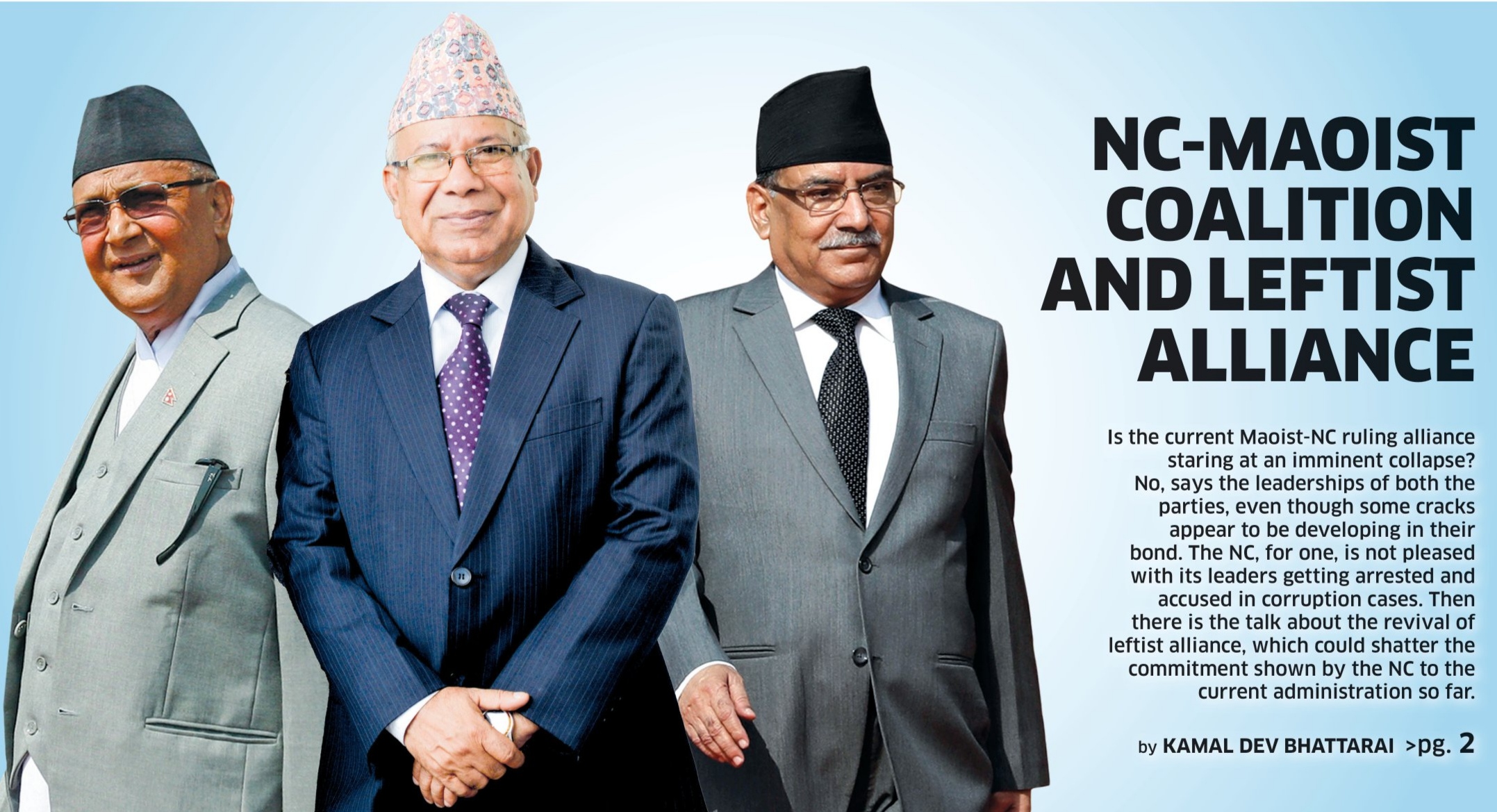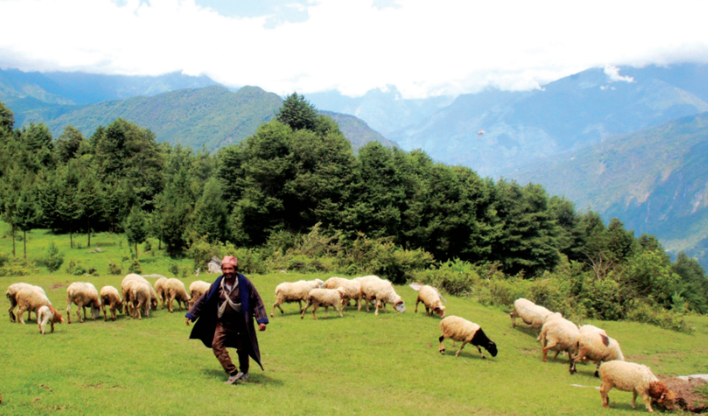SSF enforces a new guideline for workers
The Social Security Fund (SSF) on Tuesday enforced a new working guideline to provide coverage to workers from the informal sector, foreign employment, and self-employed people. Kapil Mani Gyawali, Executive Director at SSF, said the rule is aimed at managing funds for pension and security against accident and physical disability for the workers of the three categories. “Workers from these sectors will receive similar benefits as those from formal sectors,” he said. This is the first time that SSF is making an official attempt to bring migrant workers into its cover. Gyawali said these workers will be provided with long-term pensions after they are included in the social security scheme. “We will include migrant workers under the scheme while they receive the permit for employment abroad,” he added. While considering the informal and outbound workers, SSF will maintain the minimum wage fixed by the government for the contributions of the workers in the fund. “They will have to pay a certain percentage of the minimum wage as defined by our guideline,” mentioned Gyawali. For the workers from domestic informal sectors, SSF has categorized them into four types—household, agriculture, construction and transport. Those falling under these categories will be identified as recommended by local governments. An analytical report on the informal sector published by the Central Bureau of Statistics shows that out of the total of 923,027 business establishments operating in Nepal, about half (460,422 firms) are not registered, and have been kept under informal enterprises. According to the report, out of the 3.22 million individuals employed in the country, 25.8 percent or 832,187 individuals are employed in the informal sector. The contribution-based Social Security Scheme is one of the most ambitious programs launched by the government in 2019. Under this, a contributor will receive cash in social security on a monthly basis after s/he retires at the age of 60. According to Gyawali, apart from the pension, the contributors’ spouse will also get medical expenses and the contributors will also get medical expenses for chronic disease. In the past three years, many public sector companies have joined the SSF. By enacting Social Security Act 2018, the government has made it mandatory also for private firms to join SSF. However, a large number of private organizations in particular are still reluctant in joining SSF, claiming a number of provisions in the SSF law are ‘impractical.’ According to them, the scheme is still not clear in terms of double taxation and the payment mechanism, among others. In July 2021, employees of banks and financial institutions even launched protests after SSF's attempt to force banks to join the fund. Later on, the trade unions of 22 commercial banks filed a case at the Supreme Court against the SSF. According to Gyawali, the case is now under the purview of the apex court. Citing the low participation of the private sector, the government revised the SSF working guideline for the first time in December 2020. As of now, the SSF has incorporated 381,000 employees from around 18,000 formal sector organizations and has collected over Rs 26 billion in contributions from them.
Nepal, China to resume military drill
Nepal Army is making preparations to hold a military drill with the People's Liberation Army of China after a gap of two years. With China easing the covid restrictions, the two armies are finally set to hold the joint exercise, which they had been holding regularly since 2017.
According to NA spokesperson Narayan Silwal, the army has started the necessary homework for the joint drill.
“The date has not been decided yet, but we are eagerly waiting to start the joint exercise, which was stalled after 2020 due to China’s zero-covid policy. ” India and the US have already resumed joint military exercise with Nepal. In fact, a two-week long joint military exercise between the NA and the Indian Army is currently underway in Rupandehi.
Nepal and India have been holding military drills for the past 13 years. The military drill between the NA and US Army resumed from last year, and they have already held two joint exercises. While China maintains that its covid policy was the reason why the PLA did not conduct any military drills with the NA, security analyst Binoj Basnyat says the pandemic might not be the only reason.
“This is part of Beijing’s strategy. In the last two years, China may have been analyzing how things work with Indian, American and Nepali militaries.” Nepal is important for China in regards to its security strategy. “China was not going to pause the joint military drill with Nepal for long, since India and the US had already resumed theirs.”
Government apathy leads to a series of Cooperatives collapse
At a time when dark clouds of uncertainty have shrouded the country's economy, cooperative institutions have landed into financial problems leading to the collapse of such financial institutions one after another. Last week, the officials of Sunaulo Diyalo Savings and Credit Cooperative in Indrachowk, Kathmandu, went out of contact, while its depositors filed complaints against the institution at the Cooperative Department of the Kathmandu Metropolitan City (KMC). The depositors sought government intervention to recover Rs 400 million that they said they'd deposited at Diyalo. Gautam Shree Multipurpose Cooperative in Kuleshwor, Kathmandu, faced similar problems a few months ago. The operators of the cooperative have been accused of embezzling nearly Rs 2 billion in deposits by its members. Over 1,100 depositors took to the Department of Cooperatives under the Ministry of Land Management, Co-operative and Poverty Alleviation, after they failed to get back their deposits of over Rs 1.75 billion. Likewise, Asta Savings and Credit Cooperative in New Road, Kathmandu, has also been facing similar issues. Two weeks ago, 35 depositors filed complaints to recover Rs 6 million from the cooperative, after the cooperative operators suddenly went out of contact. Paritosh Poudyal, Chairman of the Nepal Federation of Savings and Credit Cooperative Unions, said malpractices in the city and town-based cooperative institutions are the main problem behind the current crisis in the cooperative sector. “The cooperatives that have their money heavily in asset class investments such as real estate and stock trading than production-oriented business, have been seen landing into financial troubles,” he said. With growing cases of misconduct by cooperative institutions, the regulators have been receiving an increasing number of complaints. The records with the KMC show that it has registered complaints against six cooperatives accused of embezzling more than Rs 40 million deposited by their members in the first four months of the current fiscal year. Devendra Poudel, Director at KMC's Cooperative Department, said many cooperatives landed into problems due to their investment in real estate and the stock market. According to him, cooperatives were unable to return the money of depositors after these sectors crumbled over the past year. He said it has become necessary to make it mandatory for the cooperatives to maintain some reserves at the Nepal Rastra Bank. "Also, the members of cooperatives themselves need to be aware of the financial situation of their respective institutions which will help to avoid problems in the future," he said. Although the number of failing cooperatives has increased significantly over the past two years, the government has hardly taken any measures to penalize the misconduct of the operators of such financial institutions. Most of the depositors of Oriental Cooperative have failed to get back their money over the past decade despite Oriental being declared problematic for the past few years. Instead, the government declared Oriental a problematic cooperative for the second time on September 22 and asked the depositors to submit claims for the amounts embezzled by the cooperative's operators. Due to the government’s dilly-dallying it is unclear whether those who've lost their deposits will ever get back the doused amounts. Keshab Prasad Poudel, Chief of the Office of Problematic Cooperative Management Committee, cited the lack of proper documents related to deposits and loans of the 'troubled cooperatives' as one of the reasons for non-action against the operators of such institutions. "Government’s commitment to resolving the issues is also important in this context," he mentioned.
Solar power developers demand NEA to return to old PPA rate
Solar power project developers have called the Nepal Electricity Authority (NEA) to return to the old power purchase agreement (PPA) rate of Rs 7.30 per unit for electricity generated from solar projects. They have argued that PPA less than this rate is unfeasible for them to produce electricity. NEA had been concluding PPAs with developers at a predetermined price of Rs 7.30 per unit as per the 'Working Procedure on Grid Connected Alternative Electric Energy Development-2017'. However, in March this year, the state-owned power utility decided to set a maximum fee of Rs 5.96 per unit to be paid to solar power producers. NEA solicited proposals from developers on November 28 to build grid-connected solar installations. The authority intends to purchase a maximum of 100MW of electricity from such solar power plants that the private investors are looking to build at 16 different places across the country. Solar power project developers have however been against the price cap set by the NEA arguing that it is not scientific. “Our executive committee meeting reached a conclusion after the calculation that less than Rs 7.30 per unit is not feasible to recover the cost in 10 years,” said Prakash Bikram Basnet, President of Solar Electric Manufacturers’ Association of Nepal. “We have also decided that our member companies won’t participate in the bid invited by the NEA until our demand is addressed.” According to Basnet, 123 solar energy companies are members of the association currently. “As many as 15 of them are involved in large-scale commercial projects,” he informed. He said that implementation of the maximum price cap imposed by NEA would mean the developers have to wait 12-15 years to recover the investment. “As the solar plants should be returned to the government including the lands covered by it after 25 years, there will be little time left to make profits from the investment,” said Basnet. NEA decided to abolish the three-year fixed pricing system and only accept bids for solar energy earlier in January. It took the step to introduce a competitive pricing mechanism in light of the declining cost of solar energy globally. Under open bidding, solar energy costs in India reached a record low of INR 2 per unit in November 2020. However, proponents of solar energy say prices of solar modules, which account for about 40 percent of costs, increased by 20 cents per watt in foreign markets like Singapore and China. According to Basnet, prices of iron and steel, cables, and shipping expenses have increased. International reports also suggest that solar and wind energy prices have risen due to supply chain constraints. However, NEA is not in favor of revising the rate as sought by the private developers. According to NEA Spokesperson Suresh Bahadur Bhattarai, the authority has set the PPA rate based on global market trends. "Those who want to participate in the bid are welcome. We have not forced them to join the bid," he said. As per NEA’s tender notice, only the companies that offer prices less than Rs 5.94 per unit will be eligible to sell electricity to NEA after developing the plant. This is for the first time that the state-owned power utility sought to buy solar power through a competitive bidding process. The bid notice states that Requests for Proposals (RfPs) must be submitted by February 26. The solar project must be finished within 18 months of the day the NEA and developer signed the PPA, according to the bid notification. The bidders cannot offer to deliver less than 1MW at the delivery point. Depending on the location, they can provide a maximum capacity set for particular places ranging from 10MW to 30MW. The bidders can propose any solar photovoltaic power-producing technologies. The developer will also be responsible for evacuating power from the plant to the nearby NEA substation, reads the RFP notice. Solar energy currently makes up a very small portion of the nation's energy mix. As of the previous fiscal year, which concluded in mid-July, up to 44 megawatts of solar energy had been connected to the national grid, according to the Ministry of Energy, Water Resources, and Irrigation. This accounts for only 1.94 percent of Nepal's total installed capacity of power projects. According to the energy ministry, Nepal generated 2268MW of electricity overall in the middle of July. As part of implementing the government policy to raise the percentage of alternative renewable sources like solar and wind to 10 percent of the total installed capacity, the power monopoly made a drive to buy solar energy in large quantities.



















